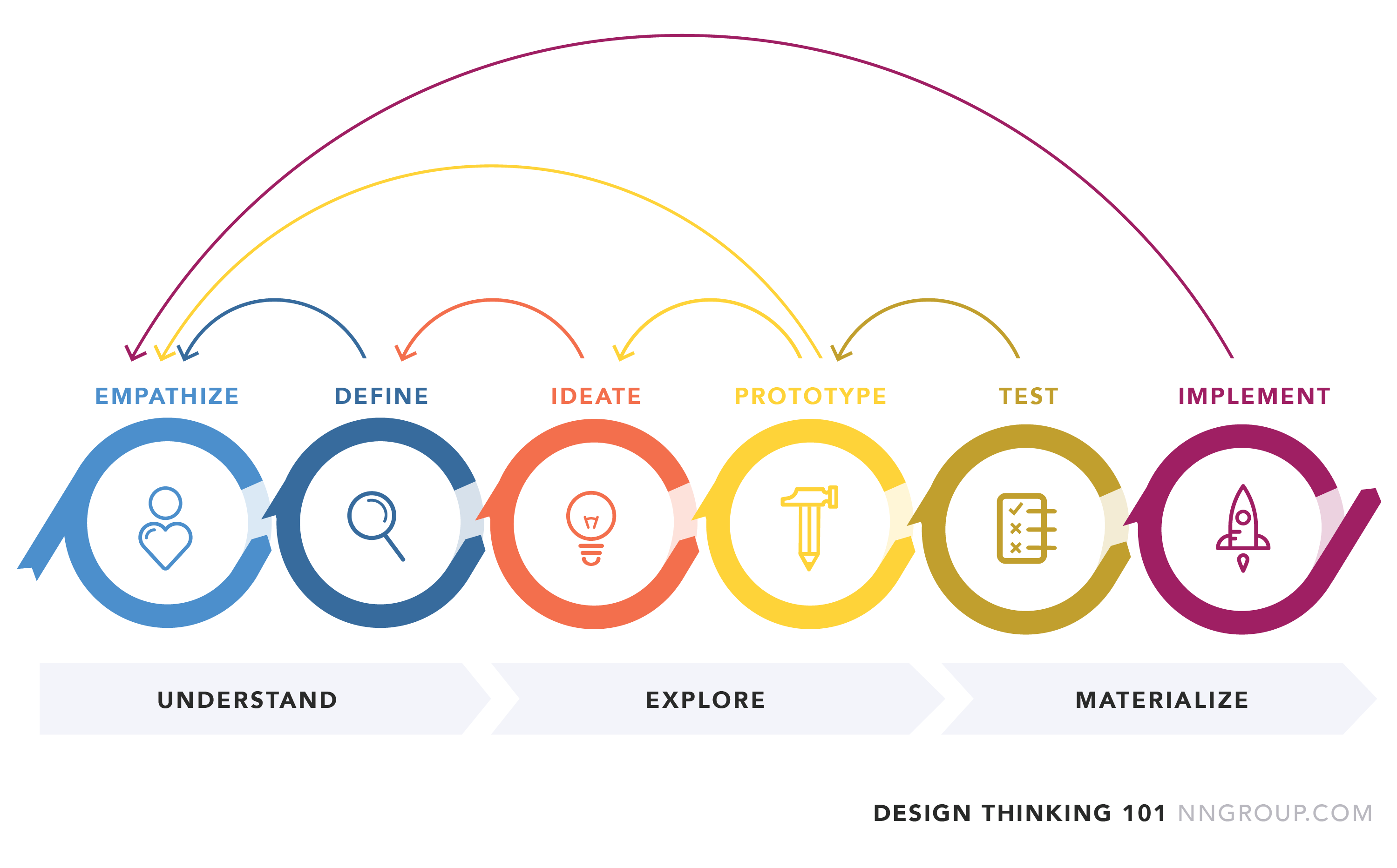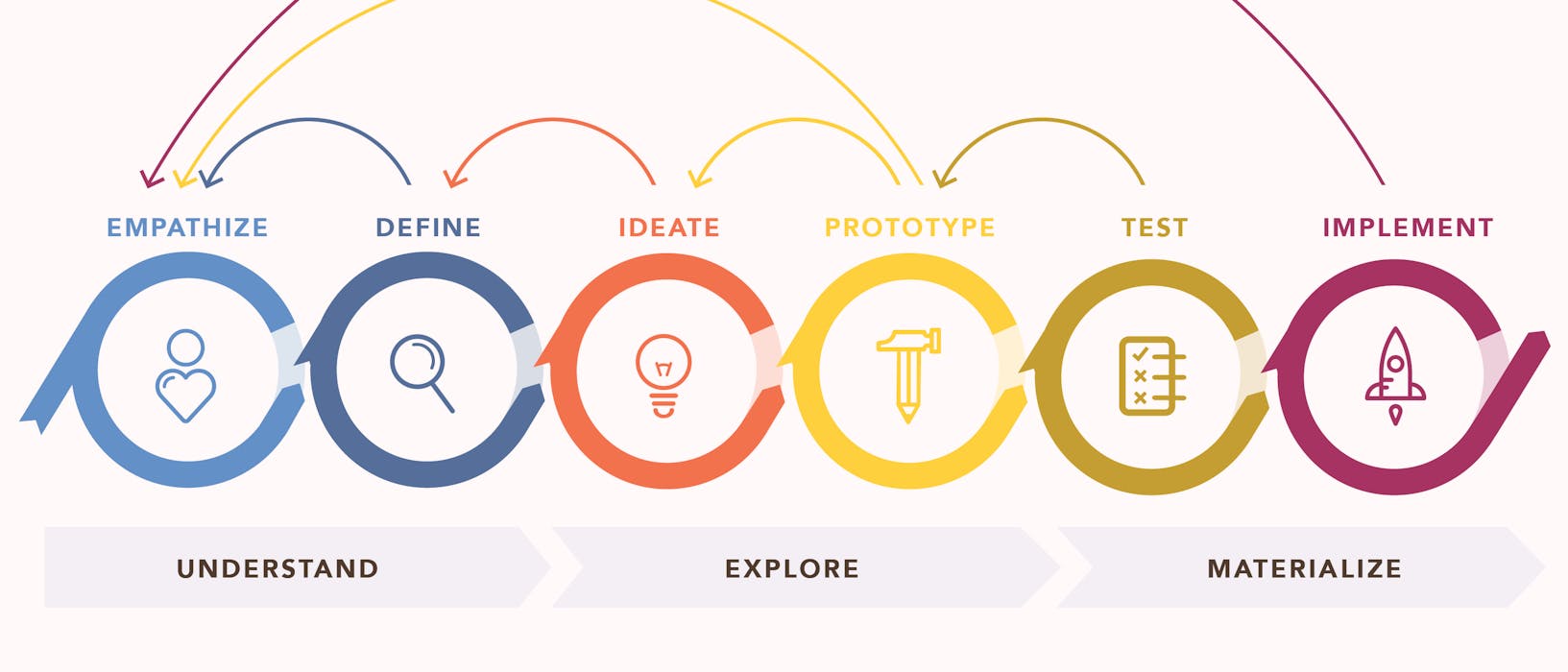Design Thinking is more than just a process designers follow to solve problems – it is an ideology that anyone can apply to almost any problem.
It turns out it's pretty good for solving business problems too. This is why Harvard Business Review, MIT and IBM encourage leaders to take Design Thinking seriously.
Design Thinking in a nutshell, with an example
Imagine your the CMO for a retail chain, and you noticed your shopping cart conversion rate is lower for mobile customers. These customers add things to their basket, but few complete the transaction.
Using design thinking, you'd take the following steps to explore and resolve the problem.

Empathise : We solve problems to help people. Empathy means understanding the viewpoint of people. In this case, you might speak to a handful of mobile customers who abandoned their carts. You learn more about their situation, what makes them tick, how they shop. It becomes apparent that customers like to add items to their basket whilst out and about, as a kind of temporary shopping list. But they end up just going to the bricks and mortar store to get the goods, because it's quicker than waiting 3 days for delivery.
Define : With this new insight, you want to reframe the problem you're solving. The problem you really need to solve is, "How do allow customers to get faster delivery so they don't just use their shopping cart as a shopping list?". Design thinking teams are comfortable spending a lot of time framing the problem because a well understood problem is so much easier to solve.
Ideate : You work to come up with ideas to solve the problem. Most teams only come up with a few ideas, but in design thinking, you're encouraged to generate more then ten ideas. This is because humans are good at finding the "obviouse" solution, but the real creativity starts when we push ourselves. In this example, let's assume we finally landed on the diea of stocking certain popular items for faster dispatch.
Prototype : You create a mock up of the new experience you want to offer to customers. There's something about seeing your ideas come to life that helps you hone them. Prototyping is relatively inexpensive, which is just one way that design thinking helps reduce costs. In this example, you chose to try the faster and more expensive delivery option during checkout.
Test : You then test this prototype on 20 customers and get feedback. You could do this by showing customers a popup, inviting them to take part of a survey. Or you might run user tests on a tool such as UserBrain.
Implement : The feedback was pretty good, 60% of customers chose the faster delivery time and reacted positively to the prototype. This suggests the investment will be a good one, it will bring a significant uplift in mobile conversions. So, you decide to move forward with this change. If the results were not acceptable, it's time to take the data and feedback and go back through the process. Perhaps you're solving the wrong problem? Or you had another idea that looked promising? Or, you simply need to invest more time in a stronger prototype?
It's a contrived example, but hopefully shows the process. Let's now look a little closer at Design Thinking.
Where it came from
The need for a structured, design-first process emerged in the early 1900s when companies started to put their designers at the start of construction processes and allowed them to consider their users’ needs before engineers started building products. Companies that started to implement user-centred design techniques saw huge success and financial reward, as a direct result of happy customers.
Design Thinking as a process was coined in the early 1990s by David Kelley and Tim Brown of IDEO. Since then, IDEO has continued to aggressively refine and test its methodology, bringing them 346 design awards since 1991 and over 1,000 patents. They’ve created user-centred solutions for some of the biggest brands in the world, including Procter & Gamble, HBO, Kodak, Pepsi Co, and Shimano. At the core of their success sit the Design Thinking principles, which are what make IDEO the go-to firm in America for innovation and user-centred design, and are an integral part of our own process here at Pocketworks.
Why it works for your users
Design Thinking is not just about achieving user-focused designs or accurate data; it is as much about the approach to solving the problem as the problem itself. It shifts the focus to put the end-user in the role of Expert. This one simple act – of prioritising users at every step of design – has a knock-on effect, as all data must be collected from users, about users, and in the context of real use cases. Subsequently, any artefacts you take back to users for testing will already be ticking some of their boxes.
Why it works for you
Innovation is built into Design Thinking from the start, as it encourages the exploration of various radical approaches to a single problem, and utilises user responses to hone a crafted solution. By taking multiple possibilities for your users to test, you drill deeper into their needs and wants, catch edge cases before they catch you, and pick up on things they didn’t even know they needed. Adopted company-wide, it facilitates team collaboration, and maximises collective knowledge, giving everyone the opportunity to suggest approaches and iterating on the results.
Why you’re glad we use it
When we pick up a project, our immediate focus is on who your users are: what problems do they face, and how can we solve them? In taking a Design Thinking approach to your problems, we make sure that we (and you) are putting your customers first, which is all the more vital in the age of social media, viral stories and bad PR.
To read more on Design Thinking follow these links – don’t just take it from us!
https://www.nngroup.com/articles/design-thinking/
https://www.fastcodesign.com/1139331/ideos-david-kelley-design-thinking

